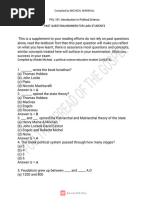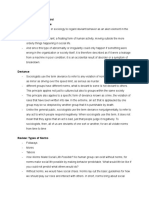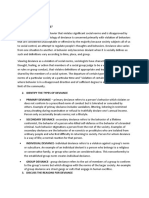0 ratings0% found this document useful (0 votes)
8 viewsSociology Cia 1
Sociology Cia 1
Uploaded by
aasthachanakya95social contruct of deviance
Copyright:
© All Rights Reserved
Available Formats
Download as DOCX, PDF, TXT or read online from Scribd
Sociology Cia 1
Sociology Cia 1
Uploaded by
aasthachanakya950 ratings0% found this document useful (0 votes)
8 views4 pagessocial contruct of deviance
Original Title
sociology cia 1
Copyright
© © All Rights Reserved
Available Formats
DOCX, PDF, TXT or read online from Scribd
Share this document
Did you find this document useful?
Is this content inappropriate?
social contruct of deviance
Copyright:
© All Rights Reserved
Available Formats
Download as DOCX, PDF, TXT or read online from Scribd
Download as docx, pdf, or txt
0 ratings0% found this document useful (0 votes)
8 views4 pagesSociology Cia 1
Sociology Cia 1
Uploaded by
aasthachanakya95social contruct of deviance
Copyright:
© All Rights Reserved
Available Formats
Download as DOCX, PDF, TXT or read online from Scribd
Download as docx, pdf, or txt
You are on page 1of 4
NAME- AASTHA CHANAKYA
CLASS & SECTION – 1st SEMESTER ‘C’
ROLL NO – 03
SUBJECT – SOCIOLOGY
SUBJECT TEACHER – MR. UTTAM
KUMAR PANDA
Social Construct Deviance
The word “deviance” sometimes suggests strange or inappropriate behaviour, in sociological
contexts, the term refers to any transgression of social standards. Deviance can take many
different forms, from infractions on the road like a traffic ticket to more serious crimes like
murder. Every civilization has its own concept of what constitutes deviation and what does not,
and these definitions vary greatly throughout societies. Deviance is defined as any behaviour that
goes against widely recognized social norms and is viewed negatively by a certain group. Put
another way, it’s behaviour that goes against what is considered appropriate in a certain culture
or group. It involves behaviours that result in negative outcomes as well as social constraints. It
also covers offenses against the community.
In order to examine current sociological and criminological perspectives on deviance, a literature
review technique was used. Along with more recent research pieces, the review features
foundational works by researchers including Émile Durkheim, Robert Merton, and Howard
Becker. To determine the main components and theoretical frameworks that explain aberrant
conduct, a conceptual analysis was done.
This study’s conceptual framework is based on three main theoretical stances:
1.Structural- Functionalism: One of the founders of structural functionalism, Émile Durkheim,
argued that deviation is a necessary component of society and has a functional role. No society
can function without some degree of deviance, in Durkheim’s view, since imperfect adherence to
social standards will always occur. Therefore, deviation is both inevitable and natural. Deviance
aids in establishing and upholding the moral limits of society. Deviant behaviour is punished,
reinforcing social norms about what is and is not acceptable. Deviance has the power to
encourage social transformation. Society may revaluate its ideals and establish new norms when
a sufficient number of individuals question the ones that already exist or when abnormal
behaviour becomes normal.
2.Strain theory: Every community, according to Merton, has culturally sanctioned objectives that
members are supposed to meet, such as achieving monetary achievement, wealth, or social
standing. Simultaneously, society offers structured ways to accomplish these ends, such as work,
education, and entrepreneurship. There is tension that can lead people to engage in deviant
behaviour when there is a gap between their objectives and the appropriate ways to achieve
them. According to Merton, people’s reactions to stress vary based on their capacity to use
legitimate means for accomplishing social objectives. He listed the following five adaptation
modes: Conformity, Innovation, Ritualism, Retreatism, Rebellion. The focus of strain theory is
on the relationship between structural inequality in society—especially economic inequality—
and abnormal behaviour. If they are unable to take advantage of legal chances, people may resort
to crime or other deviant behaviour in an attempt to succeed. This is especially true in high-
income inequality cultures, where there is a great deal of pressure to succeed by unethical means
due to the wealth difference between the rich and the poor. Lower socioeconomic groups are the
main focus of strain theory since they are more likely to feel strain because they have fewer
access to opportunities that are legal. People from underprivileged origins, for example, might
not have as many educational or career prospects, thus in order to succeed financially, they might
turn to criminal activities like drug trafficking, theft, or fraud.
3.Labeling theory: Labelling theory states that deviance is a social construct that changes based
on the individuals involved, the situation, and the response of the community. The definition of
deviance is set by the powerful, who frequently use it as an intermediary for wider social
injustices. There are two types of deviance under this theory. Primary Deviance is the term used
to describe the first instance of disobeying the rules, which may or may not lead to the person
being classified as deviant. It might be something as simple as breaching a social norm or
committing a small-time crime. When someone adopts the label of deviant as a part of who they
are, it’s known as secondary deviation. This happens frequently as a result of other people’s
reactions (e.g., police, society, peers). The term turns into a “master status” or a defining feature
of the individual’s identity, which encourages them to carry on with their abnormal behaviour.
When someone is deemed abnormal by society, they frequently face discrimination and viewed
as a stranger or someone with lower moral standards. The effects of stigma on social
relationships and self-perception are elaborated in Erving Goffman’s work. Stigmatization can
restrict a person’s access to social, professional, or educational possibilities, which could lead to
an increase in deviant conduct. The significance of social responses to abnormal conduct is the
main emphasis of labelling theory. Social control organizations, such as the media, courts, and
police, frequently exaggerate deviance by designating particular people or groups as abnormal.
Racial minorities and those from lower socioeconomic classes, for instance, are more likely to be
classified as criminals, which perpetuates prejudice and social injustices. The overrepresentation
of marginalized groups in jails and social control systems is a result of this selective
classification.
Deviant behaviour can have a variety of particular origins, and each person's motivation for
acting in a deviant manner is unique. They can, nevertheless, be categorized and arranged into
three main categories.
1.Psychological causes of deviance: A person’s mind and thinking may be influenced by the
environment in which they are raised. Deviance in both individuals and communities can also be
encouraged by frequent exposure to deviant behaviour. When vices like substance abuse, drug
and alcohol abuse, smoking, and gambling are practiced in close proximity to one another, a
similar pattern appears. People’s mindsets are negatively impacted psychologically by social
media abuse and overuse, which can result in the emergence of rebellious or unusual attitudes,
negative attitudes, and feelings of unfairness, desperation, and retaliation. Anomie or cultural
discontent could be another significant contributing reason to departure.
2.Biological behaviour of deviance: When it comes to biological variables that contribute to
deviance, an individual’s health, physical attributes, heredity, and the development and
functioning of their brain and mental aptitude all play major roles. Cesare Lombroso, an Italian
physician, further characterized deviance in criminals by characterizing them as born criminals
because of a particular trait or set of traits in their behaviour. Historically, one of the earliest
discoveries and theories supporting the understanding of the concept of deviant behaviour was
the biological basis for deviance. It takes into account an individual’s innate traits, physical
makeup, and instincts as scientific evidence for deviance and criminal behaviour. However, there
are no such conclusive data indicating that genetics or biological characteristics contribute to
deviance. This idea also emphasizes the existence of an additional chromosome in people who
typically turn to crime. Despite this, most sociologists disagree with this hypothesis because it is
impractical.
3.Sociological behaviour of deviance: The social environment in which people are raised has a
big role in how deviance develops. A person’s social background, upbringing, socialization,
family dynamics, experiences with social rejection, social and religious convictions, and poverty
can all have an impact on deviant behaviour. People experience a spectrum of emotions in
response to the labels and judgments that society places on them. . Some of the social goals that
society sets are having a nice career, a respectable house, and a luxury car. Time constraints are
also established across generations to accomplish these goals. There is pressure to reach these
goals by a certain age, and there is inequality in the methods and means of doing so within
society, which can occasionally result in aggression. Deviant behaviour does not come naturally
to people; rather, it develops as a result of social environments and events.
Social Control and Deviance: The term “social control” refers to the procedures that society uses
to enforce rules and keep the peace. These procedures can be formal (such as laws and law
enforcement) or informal (such as peer pressure and social norms). Deviance is the management,
deterrence, and punishment of behaviour that deviates from social norms. While control theory
emphasizes strong social relationships as essential to conformity, theories such as Durkheim’s
functionalism regard deviation as vital for establishing cohesion and reinforcing norms.
According to conflict theory, deviance is seen through the prism of power, with the powerful
defining and controlling what is deemed deviant. Labelling theory emphasizes how social
responses can reinforce deviant conduct. Deviance and social control work together to create a
balance in society between change and conformity.
Cultural relativity of deviance: Since deviation is determined by society norms and values, the
cultural relativity of deviance highlights how what constitutes deviant behaviour differs among
societies, cultures, and historical times. Examples of behaviours that are considered abnormal in
one culture but normal in another include polygamy, cannabis use, and homosexuality. As
demonstrated by the growing acceptability of same-sex marriage and divorce, norms can also
shift over time. Furthermore, power dynamics play a part in designating some actions as deviant,
and subcultures may contest conventional definitions of deviance. Deviance is ultimately
determined by social and cultural settings rather than being absolute.
In conclusion, deviation is a broad term with numerous aspects that differs between societies,
cultures, and historical eras. It is determined by the standards and ideals of a certain community
rather than being an inherent trait of behaviour. Different theoretical perspectives, such as
structural functionalism, strain theory, and labelling theory, offer lenses through which to view
the origins, purposes, and effects of aberrant behaviour. Formal and informal social control
mechanisms govern behaviour and preserve order, although the definition of what is considered
abnormal is frequently influenced by power relations. The concept of cultural relativity of
deviance highlights how social norms are flexible and shows how actions that are considered
abnormal in one setting may not be in another. In the end, social control and deviation work
together to influence society transformation, cohesion, and conformity.
You might also like
- POL 101 Past Question Compiled by MarshalDocument13 pagesPOL 101 Past Question Compiled by Marshalcrusadersam1No ratings yet
- Living God's Way by Arthur Wallace PDFDocument77 pagesLiving God's Way by Arthur Wallace PDFBob Litsheim100% (1)
- Deviance, Crime Social ControlDocument21 pagesDeviance, Crime Social ControlAkashNo ratings yet
- A Term Paper Report On Social Science Topic: "Deviance"Document8 pagesA Term Paper Report On Social Science Topic: "Deviance"Manjare Hassin RaadNo ratings yet
- Deviance and Social Control NotesDocument6 pagesDeviance and Social Control NotesMargie Precillas100% (1)
- Soc Sci Module (Finals)Document51 pagesSoc Sci Module (Finals)Lary Lou VenturaNo ratings yet
- Crime, Deviance and Social ControlDocument43 pagesCrime, Deviance and Social Controllemayian.steveNo ratings yet
- Deviance in Sociology - Definition, Theories & ExamplesDocument13 pagesDeviance in Sociology - Definition, Theories & ExamplesjabbaarjaffarNo ratings yet
- Theories of DevianceDocument3 pagesTheories of Devianceapi-296097282No ratings yet
- DEVIATIONDocument10 pagesDEVIATIONJohn Lloyd LantoyNo ratings yet
- Deviance Introduction: TopicsDocument5 pagesDeviance Introduction: TopicsMuhammad AhsanNo ratings yet
- Deviane, Crime and Social Control - Simpler VersionDocument12 pagesDeviane, Crime and Social Control - Simpler VersionZayn ZarifNo ratings yet
- Theories of DevianceDocument2 pagesTheories of DevianceAleena JavedNo ratings yet
- Deviance and Social ControlDocument21 pagesDeviance and Social ControlDavid JamuNo ratings yet
- Sociology of Deviance and CrimeDocument1 pageSociology of Deviance and CrimeAbdul GhaffarNo ratings yet
- Week 9 NotesDocument10 pagesWeek 9 NotesNimra AzherNo ratings yet
- Theories of Crime CausationDocument7 pagesTheories of Crime CausationJEEHAN DELA CRUZNo ratings yet
- Gale Researcher Guide for: The Sociological Study of DevianceFrom EverandGale Researcher Guide for: The Sociological Study of DevianceNo ratings yet
- CPV Project ReportDocument12 pagesCPV Project ReporthariomNo ratings yet
- SHEHLADocument8 pagesSHEHLAAaleen KttkNo ratings yet
- Social DeviationDocument12 pagesSocial DeviationJeremiah MagcalasNo ratings yet
- Crime and DevianceDocument35 pagesCrime and DeviancezhazirabibossynovaNo ratings yet
- Conformity, Social Deviation and Social ControlDocument6 pagesConformity, Social Deviation and Social ControlFranz Romuel Asperilla100% (3)
- Meaning of Deviance BehaviorDocument18 pagesMeaning of Deviance BehaviorsaniyaNo ratings yet
- SOCY 211 Unit 1.2 NotesDocument5 pagesSOCY 211 Unit 1.2 NotesAsekhonaD.No ratings yet
- Module SixDocument8 pagesModule SixEdelwise IgnacioNo ratings yet
- Socsci 3-Module 6Document5 pagesSocsci 3-Module 6Edelwise IgnacioNo ratings yet
- Chapter 06 Deviance (Complete) 30-10-2022Document7 pagesChapter 06 Deviance (Complete) 30-10-2022yasiriqbal19750No ratings yet
- Deviation, Social Problems and ControlDocument8 pagesDeviation, Social Problems and ControlRica JoyceNo ratings yet
- Notes On Deviance and Social ControlDocument3 pagesNotes On Deviance and Social ControlhannahleeavilaNo ratings yet
- Adamawa State University, Mubi Faculty of Educational Foundations, Department of Guidance and CounsellingDocument10 pagesAdamawa State University, Mubi Faculty of Educational Foundations, Department of Guidance and CounsellingDANJUMA ADAMUNo ratings yet
- Social DevianceDocument7 pagesSocial DeviancetejiuilsNo ratings yet
- Deviance - Theories of Deviance and CrimeDocument2 pagesDeviance - Theories of Deviance and Crimemary michaelNo ratings yet
- Deviance and Social ControlDocument25 pagesDeviance and Social ControlumairNo ratings yet
- Deviance and ControlDocument8 pagesDeviance and ControlSafa QasimNo ratings yet
- DevianceDocument1 pageDevianceFrank HernandezNo ratings yet
- What Is DevianceDocument4 pagesWhat Is DevianceellaNo ratings yet
- criminologyDocument127 pagescriminologyeshas8143No ratings yet
- Sociocultural Refers To The Combination of SocialDocument8 pagesSociocultural Refers To The Combination of Socialjaymarserrano96No ratings yet
- Sociological TheoriesDocument4 pagesSociological TheoriesRanier Factor AguilarNo ratings yet
- 8606 2Document18 pages8606 2zain usmaniNo ratings yet
- Human Resource Management - Deviant BehaviorDocument17 pagesHuman Resource Management - Deviant BehaviorTP LimNo ratings yet
- INTRO CH7 DEVIANCE NewDocument92 pagesINTRO CH7 DEVIANCE NewjeninasimpNo ratings yet
- JAYBSWSRRDocument43 pagesJAYBSWSRRjairus bswNo ratings yet
- criminologyDocument19 pagescriminologyjjo835047No ratings yet
- Sociological Theories of CrimeDocument34 pagesSociological Theories of CrimeMim- anshaNo ratings yet
- Social control is the active or passive process of a group regulating itself according to its beliefsDocument3 pagesSocial control is the active or passive process of a group regulating itself according to its beliefsJuliannie LinggayoNo ratings yet
- Module 2 Crim 5Document6 pagesModule 2 Crim 5nicholas castilloNo ratings yet
- Socy101: Sociology: Lecture-24 Topic: Crime and DevianceDocument19 pagesSocy101: Sociology: Lecture-24 Topic: Crime and DevianceSaad Nadeem 090No ratings yet
- Social Conformity and DevianceDocument2 pagesSocial Conformity and DevianceM. H MahiNo ratings yet
- 9 Deviance and Social ControlDocument7 pages9 Deviance and Social ControlEmmanuel S. CaliwanNo ratings yet
- criminology notesDocument308 pagescriminology notesallahdadNo ratings yet
- LECTURE D2 Deviance PDFDocument27 pagesLECTURE D2 Deviance PDFPuyatnako100% (1)
- The Sociological Perspective on Deviance and Social ControlDocument3 pagesThe Sociological Perspective on Deviance and Social Controljasandeep2006No ratings yet
- Socio - Lect 10Document29 pagesSocio - Lect 10Abdul BasitNo ratings yet
- Deviance and Conformity WORDDocument2 pagesDeviance and Conformity WORDqiritical99No ratings yet
- Deviance: Deviance and Social StigmaDocument3 pagesDeviance: Deviance and Social StigmaThanh ChauNo ratings yet
- DevianceDocument7 pagesDevianceShaira Mae CuevillasNo ratings yet
- Four Theoretical Approaches: Expected Rules and Norms Sociological PerspectiveDocument81 pagesFour Theoretical Approaches: Expected Rules and Norms Sociological Perspectivemuhammad salmanNo ratings yet
- Deviance ExamDocument13 pagesDeviance Exampatorai.ameraidahNo ratings yet
- Devian BehaviorDocument4 pagesDevian BehaviorAhmedNo ratings yet
- Lecture 7 DevianceDocument26 pagesLecture 7 DevianceTia WhoserNo ratings yet
- Cape Coral Land Use Rewrite ChangesDocument41 pagesCape Coral Land Use Rewrite ChangesNews-PressNo ratings yet
- Homework Wendy (Corregido)Document4 pagesHomework Wendy (Corregido)Sofi AriasNo ratings yet
- The Sunbearer Trials (The Sunbearer Duology 1) Aiden Thomas 2024 scribd downloadDocument29 pagesThe Sunbearer Trials (The Sunbearer Duology 1) Aiden Thomas 2024 scribd downloadhumkeehret2g100% (1)
- 03 Quiz 1 AubDocument3 pages03 Quiz 1 Aubken dahunanNo ratings yet
- BNCC TutorialDocument13 pagesBNCC Tutorialtalibhsn100% (1)
- nighthawk-app.comDocument11 pagesnighthawk-app.comperrygillwanNo ratings yet
- Be The Church PDFDocument2 pagesBe The Church PDFJames ThamNo ratings yet
- Big Rafif Asyam Bahi 210810301014 English eDocument7 pagesBig Rafif Asyam Bahi 210810301014 English eAlan NurulNo ratings yet
- LIST OF CONTRACTS AWARDED (FROM 01.10.2019 To 31.12.2019)Document3 pagesLIST OF CONTRACTS AWARDED (FROM 01.10.2019 To 31.12.2019)Aashish PardeshiNo ratings yet
- NGOs and NPOs PDFDocument2 pagesNGOs and NPOs PDFkartikNo ratings yet
- Lesson 1Document35 pagesLesson 1Aprile Margareth Hidalgo100% (1)
- Admission-Schedule-Spring-2025Document1 pageAdmission-Schedule-Spring-2025Rawalpindi Arts CouncilNo ratings yet
- Ashoka The Emperor Who Gave Up WarDocument10 pagesAshoka The Emperor Who Gave Up WarAryaNo ratings yet
- NBRC Taxes Summary 2022Document13 pagesNBRC Taxes Summary 2022Edwin AurellanoNo ratings yet
- VT EstDocument4 pagesVT Estmicroproject261No ratings yet
- Materi Yan HCDocument15 pagesMateri Yan HCdimas ananda setiawanNo ratings yet
- Reso BarDocument2 pagesReso BarBarangay ChamberyNo ratings yet
- He Pros and Cons About Sharing Our Culture With TouristsDocument2 pagesHe Pros and Cons About Sharing Our Culture With TouristsGeraldineNo ratings yet
- Elmhurst Teacher's Council's Filing With The Illinois Educational Labor Relations BoardDocument27 pagesElmhurst Teacher's Council's Filing With The Illinois Educational Labor Relations BoardDavid GiulianiNo ratings yet
- Chronicles (1950) : Study Guide For Ray Bradbury's The MartianDocument4 pagesChronicles (1950) : Study Guide For Ray Bradbury's The MartianSam UelNo ratings yet
- Bankruptcy of A Retail GiantDocument2 pagesBankruptcy of A Retail GiantVibhu SinghNo ratings yet
- Đề HSG trường Giấy 24-25Document11 pagesĐề HSG trường Giấy 24-25Tuấn TúNo ratings yet
- The Mood Decides The Fortunes of PeopleDocument1 pageThe Mood Decides The Fortunes of Peoplend85vrb44tNo ratings yet
- MW STJ 08252016Document34 pagesMW STJ 08252016medtechyNo ratings yet
- Akb 2Document9 pagesAkb 2Dani m DarmawanNo ratings yet
- Essays On Different TopicsDocument4 pagesEssays On Different TopicsWajeeha WaheedNo ratings yet
- Power Services Quality ManualDocument35 pagesPower Services Quality ManualAvatar JiNo ratings yet
- F2.1 - Field KioskDocument5 pagesF2.1 - Field KioskKwan Chun SingNo ratings yet

























































































